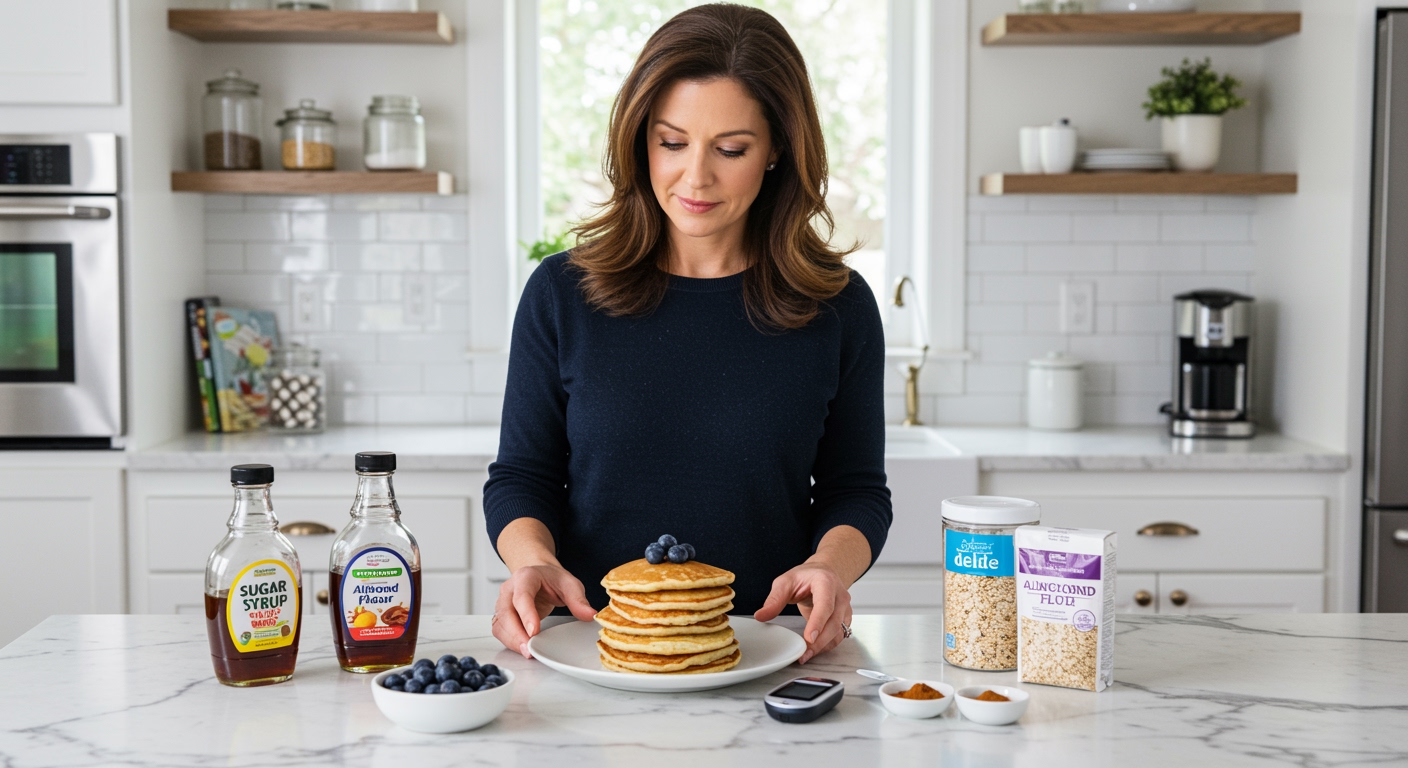✪ Key Takeaway: Traditional pancakes spike blood sugar dangerously, but smart ingredient swaps make diabetes-friendly versions possible.
Introduction
The smell of pancakes cooking on Sunday morning brings back childhood memories for most people.
But if you have diabetes, that stack of fluffy pancakes might feel like forbidden territory because you worry about blood sugar spikes.
Hi, I’m Abdur, your nutrition coach and today I’m going to explain exactly how pancakes affect your blood sugar and show you practical ways to enjoy them safely.
Why Do Regular Pancakes Spike Blood Sugar So High?
Traditional pancakes are basically refined flour mixed with sugar and cooked into a fluffy disc.
Your body breaks down this white flour into glucose faster than you can say “maple syrup.”
Most pancake mixes contain around 30-40 grams of carbohydrates per serving before you add any toppings.
The glycemic index of regular pancakes sits around 67, which puts them in the high category for blood sugar impact.
When you pour syrup on top, you are adding another 12-15 grams of pure sugar per tablespoon.
This combination hits your bloodstream like a sugar tsunami, causing rapid spikes that can be dangerous for people with diabetes.
✪ Fact: A typical restaurant pancake stack contains 60-80 grams of carbohydrates before syrup.
What Makes Some Pancakes Better For Blood Sugar?
The secret lies in choosing ingredients that slow down glucose absorption in your digestive system.
Protein and healthy fats act like speed bumps for sugar, preventing those dangerous spikes.
Almond flour pancakes contain about 6 grams of protein and 14 grams of healthy fats per serving compared to almost zero in regular pancakes.
The fiber content in alternative flours also helps slow digestion and keeps blood sugar more stable.
Coconut flour provides 5 grams of fiber per quarter cup, while white flour gives you less than 1 gram.
These nutrient-dense alternatives also keep you feeling full longer, preventing the blood sugar rollercoaster that leads to more cravings.
✪ Pro Tip: Add 1-2 tablespoons of ground flaxseed to any pancake batter for extra fiber and omega-3 fats.
Which Pancake Ingredients Should You Choose?
Almond flour makes the best base because it contains only 3 grams of net carbs per quarter cup.
Coconut flour works well too, but you need less because it absorbs more liquid than regular flour.
Eggs become your best friend in diabetes-friendly pancakes because they add structure and protein without any carbs.
Greek yogurt can replace some of the liquid while adding probiotics and extra protein to slow sugar absorption.
For sweetness, use stevia, monk fruit, or erythritol instead of sugar to avoid blood sugar spikes.
Cinnamon not only adds flavor but also helps improve insulin sensitivity according to research studies.
Vanilla extract gives you sweetness perception without adding any actual sugar to the recipe.
✪ Note: Start with half the amount when using coconut flour because it absorbs much more liquid than other flours.
How Should You Time Your Pancake Meals?
Morning is actually the best time to eat pancakes if you have diabetes.
Your body produces more insulin naturally in the morning, which helps process carbohydrates more effectively.
Eating pancakes after a workout also helps because your muscles act like sponges for glucose.
Never eat pancakes on an empty stomach because this causes the fastest blood sugar spike possible.
Try eating a small portion of protein or nuts 15 minutes before your pancakes to slow absorption.
Avoid pancakes late at night when your metabolism slows down and insulin sensitivity decreases.
✪ Pro Tip: Take a 10-15 minute walk after eating pancakes to help your muscles use up excess glucose.
What Toppings Keep Blood Sugar Stable?
Forget the maple syrup and try sugar-free alternatives that taste just as good.
Fresh berries add natural sweetness plus fiber and antioxidants that help control blood sugar.
Nut butters provide healthy fats and protein that slow down carb absorption significantly.
A dollop of Greek yogurt adds probiotics and protein while keeping the creamy texture you love.
Unsweetened whipped cream made from heavy cream contains almost zero carbs and adds richness.
Cinnamon and vanilla extract can make your pancakes taste sweeter without adding any actual sugar.
Chopped nuts provide healthy fats, protein, and a satisfying crunch that helps you feel full longer.
✪ Fact: Two tablespoons of almond butter contains 7 grams of protein and only 4 grams of net carbs.
The Bottom Line
Regular pancakes will spike your blood sugar dangerously high, but smart ingredient swaps make diabetes-friendly versions completely possible.
Food should bring joy, not fear, even when you have diabetes.
I would love to hear about your favorite pancake modifications or any questions you have about managing blood sugar with breakfast foods in the comments below.
References
At NutritionCrown, we use quality and credible sources to ensure our content is accurate and trustworthy. Below are the sources referenced in creating this article:
- Tap Health: Can a Diabetic Have Pancakes?
- Glycemic Index: Pancakes Plain Dry Mix Complete Includes Buttermilk
- Diabetes Strong: Diabetic Pancakes
- Hangry Woman: Almond Flour Pancakes





